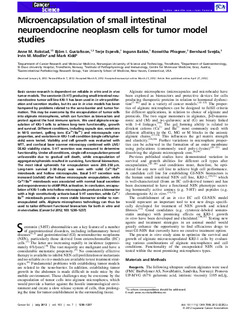| dc.description.abstract | Basic cancer research is dependent on reliable in vitro and in vivo tumor models. The serotonin (5‐HT) producing small intestinal neuroendocrine tumor cell line KRJ‐1 has been used in in vitro proliferation and secretion studies, but its use in in vivo models has been hampered by problems related to the xeno‐barrier and tumor formation. This may be overcome by the encapsulation of tumor cells into alginate microspheres, which can function as bioreactors and protect against the host immune system. We used alginate encapsulation of KRJ‐1 cells to achieve long‐term functionality, growth and survival. Different conditions, including capsule size, variations in M/G content, gelling ions (Ca2+/Ba2+) and microcapsule core properties, and variations in KRJ‐1 cell condition (single cells/spheroids) were tested. Viability and cell growth was evaluated with MTT, and confocal laser scanner microscopy combined with LIVE/DEAD viability stains. 5‐HT secretion was measured to determine functionality. Under all conditions, single cell encapsulation proved unfavorable due to gradual cell death, while encapsulation of aggregates/spheroids resulted in surviving, functional bioreactors. The most ideal spheroids for encapsulation were 200–350 μm. Long‐term survival (>30 days) was seen with solid Ca2+/Ba2+ microbeads and hollow microcapsules. Basal 5‐HT secretion was increased (sixfold) after hollow microcapsule encapsulation, while Ca2+/Ba2+ microbeads was associated with normal basal secretion and responsiveness to cAMP/PKA activation. In conclusion, encapsulation of KRJ‐1 cells into hollow microcapsules produces a bioreactor with a high constitutively activate basal 5‐HT secretion, while Ca2+/Ba2+ microbeads provide a more stable bioreactor similar to non‐encapsulated cells. Alginate microspheres technology can thus be used to tailor different functional bioreactors for both in vitro and in vivo studies. (Cancer Sci 2012; 103: 1230–1237). | nb_NO |
